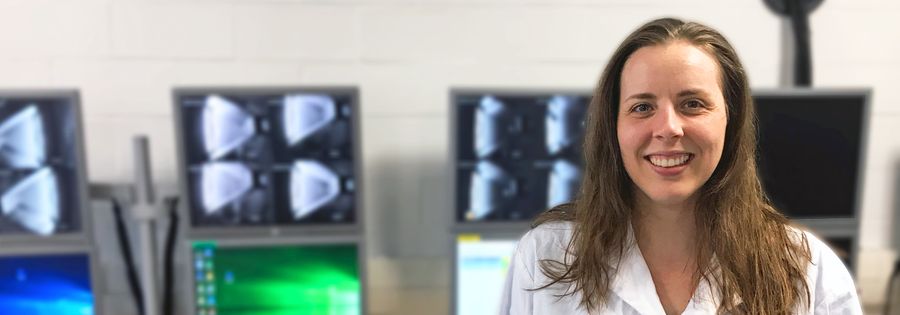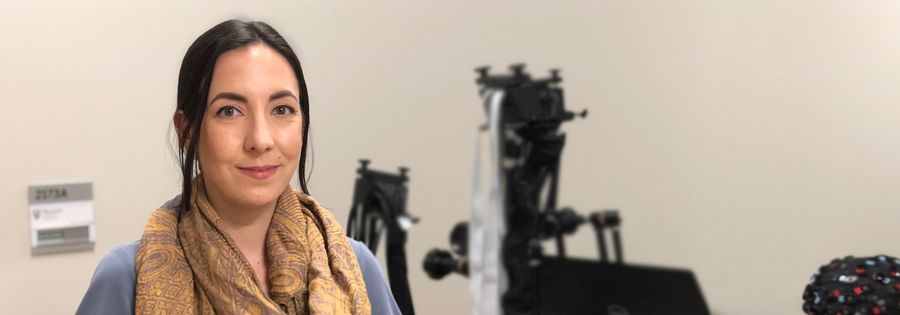BrainsCAN celebrates International Day of Women and Girls in Science
A diverse scientific community strengthens research innovation and excellence. Western University is home to extraordinary women researchers who are contributing to cutting-edge science discoveries. Many of these researchers have become role models for the next generation of scientists. In the early 2000s, BrainsCAN’s Co-Scientific Director, Dr. Lisa Saksida, co-invented rodent touchscreen technology to test rodents in ways that resemble human tests. Now used by labs worldwide, this innovative technology is helping researchers better understand the psychological processes underlying memory and perception.
For International Day of Women and Girls in Science, we’re highlighting three BrainsCAN core staff members who are contributing to cutting-edge research. Learn about their current role in neuroscience and how they became interested in the subject.

Julie Dumont
What is your role?
I am responsible for developing behavioural platforms. These platforms provide other researchers with baseline knowledge. I also encourage open access by educating and training others on using the touchscreen research equipment. The end game is helping people. If we can help people improve the quality of their research and findings by giving them tools, training and opportunities to communicate, then we’re going to improve the likelihood of translation of these findings to benefit people with brain disorders.
How did you get interested in science?
I wasn’t a kid that you’d consider a “scientist”. I went to university not knowing what to do. During my first year in a psychology course, I learned about how different areas of the brain allowed you to think, or act with your environment. It made me think: how are memories formed and stored, and how reliable are our own memories? I got really interested and fascinated in the brain that way.
What role models influenced your path in science?
In my undergrad at McGill University, I applied to work with Dr. Viviane Sziklas in her lab. She took a chance on me and I ended up completing my honours thesis with her. She is one of my role models; she’s a clinician who has patients, but still keeps a lab going because she loves research.
Now I share my knowledge by taking part in science outreach with kids. I like telling them about the brain and listening to their ideas. I try to show kids what science is like and what research is like, so they can find the right path for them.

Nicolette Noonan
Sleep and Electrophysiology Laboratory Coordinator, BrainsCAN Human Cognition & Sensorimotor Core
Master of Science, Speech Language Sciences
Doctor of Philosophy, Cognitive Science/Psychology
What is your role?
I am in charge of facilitating research that happens on our non-MRI imaging devices (sleep research, EEG, or fNIRS). I’m responsible for running that equipment, and helping researchers design their studies using these different neuroimaging devices. One of my main goals in this role is to optimize our research in a way that takes advantage of these different pieces of imaging equipment.
How did you get interested in science?
I didn’t go into university originally thinking that I wanted to do science, but I took first year psychology and absolutely loved it. I was really interested in how the human mind functions and how we interact with our world and the people within our world. What really caught my interest in psychology was the study of language development; how do we go from being a baby born into the world, a seemingly blank slate, to being able to use and understand language in a sophisticated way? How does that process unfold? But I had no idea that I had this interest until I took that first year psychology course.
What role models influenced your path in science?
Having strong women role models played a role in my path, including my course instructor in fourth year, Dr. Mary Lou Vernon and my PhD advisor, Dr. Lisa Archibald.
In 2018, myself and two friends organized the Inspiring Young Women in STEM Conference. We wanted to inspire young women to continue with their STEM interests and pursuits, at both the academic and non-academic routes. The goal was to give young women the tools to help them continue and tell them there is no ceiling to what you can achieve within those domains. We’ve recently re-dubbed this conference the Inspiring Diversity in STEM Conference, to be inclusive of the many different underrepresented groups in STEM.

Suzanne T. Witt
Neuroimaging Analyst, BrainsCAN Computational Core
MS, PhD Medical Physics
What is your role?
I help facilitate other researchers' functional magnetic resonance imaging (fMRI) research. I help problem-solve and take care of analyses. I work with researchers who have a vision and I help them figure out how to make that a practical reality. I find it all a big puzzle that mixes everything I like about linear algebra, imaging, the brain and neuroscience. It’s a nice combination of physics, math and biology.
How did you get interested in science?
I’ve always had an interest in science. I had a summer job with the research radiology department at Indiana University and that’s where I was introduced to fMRI. The first time I saw the results of an fMRI experiment – so a picture of a brain – and then someone explained how it works... I just thought it was utterly fascinating.
What role models influenced your path in science?
Both of my parents were medical physicists. When you have a mother who’s a physicist, particularly when she went through her university and graduate school studies in the sixties and seventies, it was just natural to see her and think, "oh, that’s what women do."






